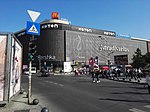Piața Unirii

Piața Unirii (Romanian pronunciation: [ˈpjat͡sa uˈnirij]; Unification Square or Union Square in English) is one of the largest squares in central Bucharest, Romania, located in the center of the city where Sectors 1, 2, 3, and 4 meet. Part of the Civic Centre, it is bisected by Unirii Boulevard, originally built during the Communist era as the Boulevard of the Victory of Socialism, and renamed after the Romanian Revolution. The square is a significant transport hub, containing the Piața Unirii metro station and a major interchange for STB buses; there is also a tram terminal near the southwest corner. The Unirea Shopping Center, the Cocor department store and a large taxi rank are located on the east side of this square, while Hanul lui Manuc is on the north side, near the northeast corner. The centre of the square boasts a small park and fountains which are particularly popular with commuters and passers-by in the torrid summer months. There were plans to build the Romanian National Salvation Cathedral on the place of this park, but the idea proved technically impossible due to the busy underground environment and lack of popularity among local citizens and therefore the location was changed. The square features a large Christmas tree erected every December.
Excerpt from the Wikipedia article Piața Unirii (License: CC BY-SA 3.0, Authors, Images).Piața Unirii
Pasajul Pietonal Metrou Unirii, Bucharest Centrul Civic (Sector 3)
Geographical coordinates (GPS) Address Nearby Places Show on map
Geographical coordinates (GPS)
| Latitude | Longitude |
|---|---|
| N 44.427997222222 ° | E 26.102172222222 ° |
Address
Piața Unirii 1
Pasajul Pietonal Metrou Unirii
030119 Bucharest, Centrul Civic (Sector 3)
Romania
Open on Google Maps









